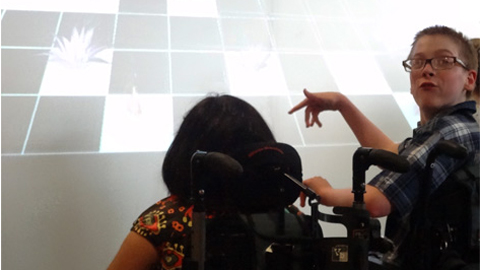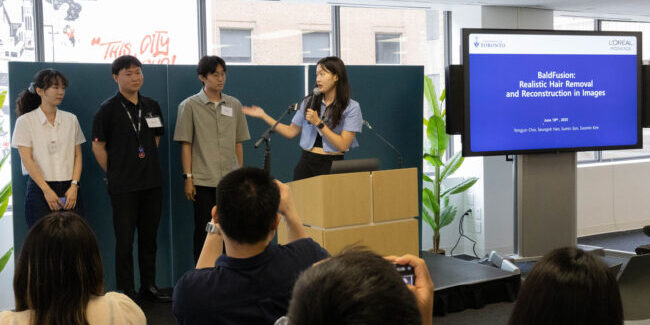
As a regular outpatient with cerebral palsy, 12-year-old Caleb spends a lot of time in waiting rooms. It hasn’t always been as fun as it is now.
Caleb was just one of the children from a focus group who helped launch ScreenPlay, an interactive waiting room installation, on May 18 at the Holland Bloorview Kids Rehabilitation Hospital.
Designed by Professor Elaine Biddiss, a scientist at the Bloorview Research Institute and a faculty member at the Institute of Biomaterials & Biomedical Engineering (IBBME), the installation boasts a pressure-sensitive floor comprised of 100 sensors. Calibrated from the microcontroller switches in the tiles, information is fed to a computer that then applies corresponding images to a glass wall from a ceiling-mounted projector. Anyone standing or sitting on the tiles can create elaborate, moving landscapes from the three rotating design motifs: flowers and bubbles, a forest blooming from a geometric grid, and abstract vines and patterns.
“We have a very vulnerable population here,” Professor Biddiss explained, and traditional waiting room toys have contact surfaces that easily spread infections. As many of the patients face mobility challenges, games requiring hand dexterity – including traditional and video games – are not practical. ScreenPlay allows anyone to interact without ever having to touch a contact surface or anyone else.
The longer a patient remains in one spot, the bigger the projection becomes, which allows those with the least amount of mobility to create the largest images. The floor likewise promotes collaborative fun: multiple children of all abilities can play together on the floor to create wall-sized forests, for instance.
“The only thing that all these kids have in common is that if you’re standing or sitting, you have gravity on your side. You have presence, and that presence is something we can always detect,” Professor Biddiss stated.
She noted that ScreenPlay was a “very collaborative effort” between engineers, the Holland Bloorview Kids Rehabilitation Hospital Foundation, as well as students from OCAD University who created the projector images for an interactive communications class.
Supported by a foundation established to honour the late Dr. Tammy Kagan-Kusher, the installation isn’t all just fun and games. The project was awarded a Canadian Institutes of Health Research grant that Professor Biddiss will use to study the effects of this type of interactive play on patient stress-levels and overall experience.
If Caleb’s grin is anything to go by, ScreenPlay is already a resounding success.



